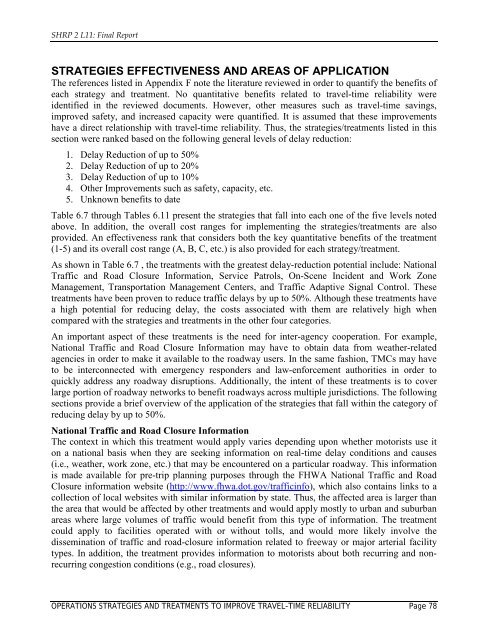Evaluating Alternative Operations Strategies to Improve Travel Time ...
Evaluating Alternative Operations Strategies to Improve Travel Time ...
Evaluating Alternative Operations Strategies to Improve Travel Time ...
Create successful ePaper yourself
Turn your PDF publications into a flip-book with our unique Google optimized e-Paper software.
SHRP 2 L11: Final Report<br />
STRATEGIES EFFECTIVENESS AND AREAS OF APPLICATION<br />
The references listed in Appendix F note the literature reviewed in order <strong>to</strong> quantify the benefits of<br />
each strategy and treatment. No quantitative benefits related <strong>to</strong> travel-time reliability were<br />
identified in the reviewed documents. However, other measures such as travel-time savings,<br />
improved safety, and increased capacity were quantified. It is assumed that these improvements<br />
have a direct relationship with travel-time reliability. Thus, the strategies/treatments listed in this<br />
section were ranked based on the following general levels of delay reduction:<br />
1. Delay Reduction of up <strong>to</strong> 50%<br />
2. Delay Reduction of up <strong>to</strong> 20%<br />
3. Delay Reduction of up <strong>to</strong> 10%<br />
4. Other <strong>Improve</strong>ments such as safety, capacity, etc.<br />
5. Unknown benefits <strong>to</strong> date<br />
Table 6.7 through Tables 6.11 present the strategies that fall in<strong>to</strong> each one of the five levels noted<br />
above. In addition, the overall cost ranges for implementing the strategies/treatments are also<br />
provided. An effectiveness rank that considers both the key quantitative benefits of the treatment<br />
(1-5) and its overall cost range (A, B, C, etc.) is also provided for each strategy/treatment.<br />
As shown in Table 6.7 , the treatments with the greatest delay-reduction potential include: National<br />
Traffic and Road Closure Information, Service Patrols, On-Scene Incident and Work Zone<br />
Management, Transportation Management Centers, and Traffic Adaptive Signal Control. These<br />
treatments have been proven <strong>to</strong> reduce traffic delays by up <strong>to</strong> 50%. Although these treatments have<br />
a high potential for reducing delay, the costs associated with them are relatively high when<br />
compared with the strategies and treatments in the other four categories.<br />
An important aspect of these treatments is the need for inter-agency cooperation. For example,<br />
National Traffic and Road Closure Information may have <strong>to</strong> obtain data from weather-related<br />
agencies in order <strong>to</strong> make it available <strong>to</strong> the roadway users. In the same fashion, TMCs may have<br />
<strong>to</strong> be interconnected with emergency responders and law-enforcement authorities in order <strong>to</strong><br />
quickly address any roadway disruptions. Additionally, the intent of these treatments is <strong>to</strong> cover<br />
large portion of roadway networks <strong>to</strong> benefit roadways across multiple jurisdictions. The following<br />
sections provide a brief overview of the application of the strategies that fall within the category of<br />
reducing delay by up <strong>to</strong> 50%.<br />
National Traffic and Road Closure Information<br />
The context in which this treatment would apply varies depending upon whether mo<strong>to</strong>rists use it<br />
on a national basis when they are seeking information on real-time delay conditions and causes<br />
(i.e., weather, work zone, etc.) that may be encountered on a particular roadway. This information<br />
is made available for pre-trip planning purposes through the FHWA National Traffic and Road<br />
Closure information website (http://www.fhwa.dot.gov/trafficinfo), which also contains links <strong>to</strong> a<br />
collection of local websites with similar information by state. Thus, the affected area is larger than<br />
the area that would be affected by other treatments and would apply mostly <strong>to</strong> urban and suburban<br />
areas where large volumes of traffic would benefit from this type of information. The treatment<br />
could apply <strong>to</strong> facilities operated with or without <strong>to</strong>lls, and would more likely involve the<br />
dissemination of traffic and road-closure information related <strong>to</strong> freeway or major arterial facility<br />
types. In addition, the treatment provides information <strong>to</strong> mo<strong>to</strong>rists about both recurring and nonrecurring<br />
congestion conditions (e.g., road closures).<br />
OPERATIONS STRATEGIES AND TREATMENTS TO IMPROVE TRAVEL-TIME RELIABILITY Page 78















